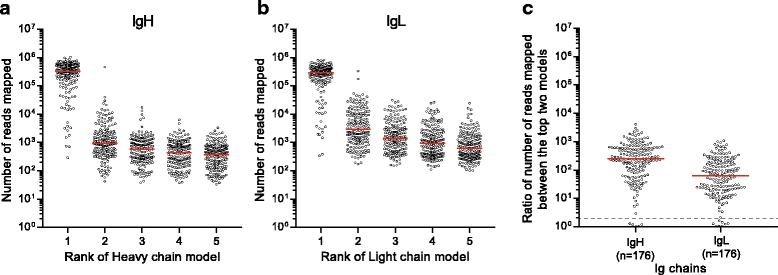BALDR: a computational pipeline for paired heavy and light chain immunoglobulin reconstruction in single-cell RNA-seq data
- PMID: 29558968
- PMCID: PMC5859752
- DOI: 10.1186/s13073-018-0528-3
BALDR: a computational pipeline for paired heavy and light chain immunoglobulin reconstruction in single-cell RNA-seq data
Abstract
B cells play a critical role in the immune response by producing antibodies, which display remarkable diversity. Here we describe a bioinformatic pipeline, BALDR (BCR Assignment of Lineage using De novo Reconstruction) that accurately reconstructs the paired heavy and light chain immunoglobulin gene sequences from Illumina single-cell RNA-seq data. BALDR was accurate for clonotype identification in human and rhesus macaque influenza vaccine and simian immunodeficiency virus vaccine induced vaccine-induced plasmablasts and naïve and antigen-specific memory B cells. BALDR enables matching of clonotype identity with single-cell transcriptional information in B cell lineages and will have broad application in the fields of vaccines, human immunodeficiency virus broadly neutralizing antibody development, and cancer.BALDR is available at https://github.com/BosingerLab/BALDR .
Conflict of interest statement
Ethics approval and consent to participate
Two healthy individuals were vaccinated with the 2016 Fluarix quadrivalent seasonal influenza vaccine. Vaccinated individuals who participated in this study provided informed consent in writing in accordance with the protocols approved by the IRB of Emory University IRB#00089789, entitled “sc-RNA-seq for clinical samples.” Peripheral blood CD19+ B cells were obtained from a healthy, unvaccinated individual who provided informed consent and was recruited under the auspices of Emory IRB#00045821, entitled “Phlebotomy of healthy adults for the purpose of evaluation and validation of immune response assays.” These protocols adhere to international guidelines established in the Declaration of Helsinki by the World Medical Association.
All rhesus macaque samples were obtained from animals undergoing vaccine studies housed at the Yerkes National Primate Research Center, which is accredited by the American Association of Accreditation of Laboratory Animal Care. This study was performed in strict accordance with the recommendations in the Guide for the Care and Use of Laboratory Animals of the National Institutes of Health, a national set of guidelines in the USA, and also to international recommendations detailed in the Weatherall Report (2006). This work received prior approval by the Institutional Animal Care and Use Committees (IACUC) of Emory University (IACUC protocol #YER-2002353-061916GA, entitled Center for HIV/AIDS Vaccine Immunology and Immunogen Discovery-Parent Project, and #2000936, entitled B-cell Biology of Mucosal Immune Protection from SIV Challenge. Appropriate procedures were performed to ensure that potential distress, pain, discomfort, and/or injury were limited to that unavoidable in the conduct of the research plan. The sedative ketamine (10 mg/kg) and/or tiletamine/zolazepam (Telazol, 4 mg/kg) was applied as necessary for blood draws, and analgesics were used when determined appropriate by veterinary medical staff.
Consent for publication
Not applicable.
Competing interests
The authors declare that they have no competing interests.
Publisher’s Note
Springer Nature remains neutral with regard to jurisdictional claims in published maps and institutional affiliations.
Figures







Similar articles
-
Phenotypic Characterization of Chinese Rhesus Macaque Plasmablasts for Cloning Antigen-Specific Monoclonal Antibodies.Front Immunol. 2019 Oct 11;10:2426. doi: 10.3389/fimmu.2019.02426. eCollection 2019. Front Immunol. 2019. PMID: 31681312 Free PMC article.
-
Potent neutralizing antibodies elicited by dengue vaccine in rhesus macaque target diverse epitopes.PLoS Pathog. 2019 Jun 6;15(6):e1007716. doi: 10.1371/journal.ppat.1007716. eCollection 2019 Jun. PLoS Pathog. 2019. PMID: 31170257 Free PMC article.
-
Sequences of the Lym-1 antibody heavy and light chain variable regions.Nucleic Acids Res. 1990 Sep 11;18(17):5281. doi: 10.1093/nar/18.17.5281. Nucleic Acids Res. 1990. PMID: 2119497 Free PMC article. No abstract available.
-
Human antibodies from transgenic mice.Int Rev Immunol. 1995;13(1):65-93. doi: 10.3109/08830189509061738. Int Rev Immunol. 1995. PMID: 7494109 Review.
-
Generation of bispecific and tandem diabodies.Methods Mol Biol. 2002;178:317-31. doi: 10.1385/1-59259-240-6:317. Methods Mol Biol. 2002. PMID: 11968501 Review. No abstract available.
Cited by
-
Evaluation of T Cell Receptor Construction Methods from scRNA-Seq Data.Genomics Proteomics Bioinformatics. 2025 Jan 15;22(6):qzae086. doi: 10.1093/gpbjnl/qzae086. Genomics Proteomics Bioinformatics. 2025. PMID: 39666949 Free PMC article.
-
The Application of Single-Cell RNA Sequencing in Vaccinology.J Immunol Res. 2020 Aug 6;2020:8624963. doi: 10.1155/2020/8624963. eCollection 2020. J Immunol Res. 2020. PMID: 32802896 Free PMC article. Review.
-
Longevity, clonal relationship, and transcriptional program of celiac disease-specific plasma cells.J Exp Med. 2021 Feb 1;218(2):e20200852. doi: 10.1084/jem.20200852. J Exp Med. 2021. PMID: 33095260 Free PMC article.
-
bcRflow: a Nextflow pipeline for characterizing B cell receptor repertoires from non-targeted transcriptomic data.NAR Genom Bioinform. 2024 Oct 15;6(4):lqae137. doi: 10.1093/nargab/lqae137. eCollection 2024 Sep. NAR Genom Bioinform. 2024. PMID: 39411512 Free PMC article.
-
Insights From Analysis of Human Antigen-Specific Memory B Cell Repertoires.Front Immunol. 2019 Jan 15;9:3064. doi: 10.3389/fimmu.2018.03064. eCollection 2018. Front Immunol. 2019. PMID: 30697210 Free PMC article. Review.
References
-
- Lefranc M-P, Lefranc G. The immunoglobulin factsbook. London: Academic Press; 2001.
Publication types
MeSH terms
Substances
Grants and funding
LinkOut - more resources
Full Text Sources
Other Literature Sources

